
User Intent
“Today, people don’t follow a linear path from becoming aware of a product, to expressing interest in it, and finally to purchasing.
They show more or less interest at unique and unpredictable moments.
People turn to their devices for immediate answers.
And every time they do, they express their intent and reshape the concept of traditional marketing.” [Think with Google]
Let’s take 2 examples.
An electrical engineer, George, loves gadgets. He likes to search the internet for new releases and upgrades of electronic devices and knows exactly which brand and product he wants to buy.
On the other hand, a sales director, Elena, is looking for a gadget exactly at the moment she needs it to replace an old one.
Since both have different interests and needs, their preferences, choices, and behavior patterns until they finalize the purchase will be different.
George will prefer to buy a product from a limited number of manufacturers he trusts, mainly due to his thorough research on the new product features.
At the same time, Elena has many options to choose from and will likely rely on reviews from others with similar needs, what’s best seller, on an offer, or something recommended by a colleague.
This example vividly illustrates the concept of Search Intent.
Also known as user intent, Search Intent is the primary goal a user has when typing a query into a search engine.
Types of Searches
Before we get to why search intent is important for an online presence, let’s take a quick look at how the buyer’s journey has evolved over the years.
Since the earliest years of marketing science, the term “customer journey” was used to map and optimize the buyer’s individual steps, to facilitate and increase sales.
Today, however, the scenario is no longer the same.
Today more depth is given to decision making and then to the final purchase stage.
Prospective customers no longer enter at the top of the traditional customer journey “pyramid” (fig. 10.1), but at any stage.
Image 10.1: The traditional “customer journey”.
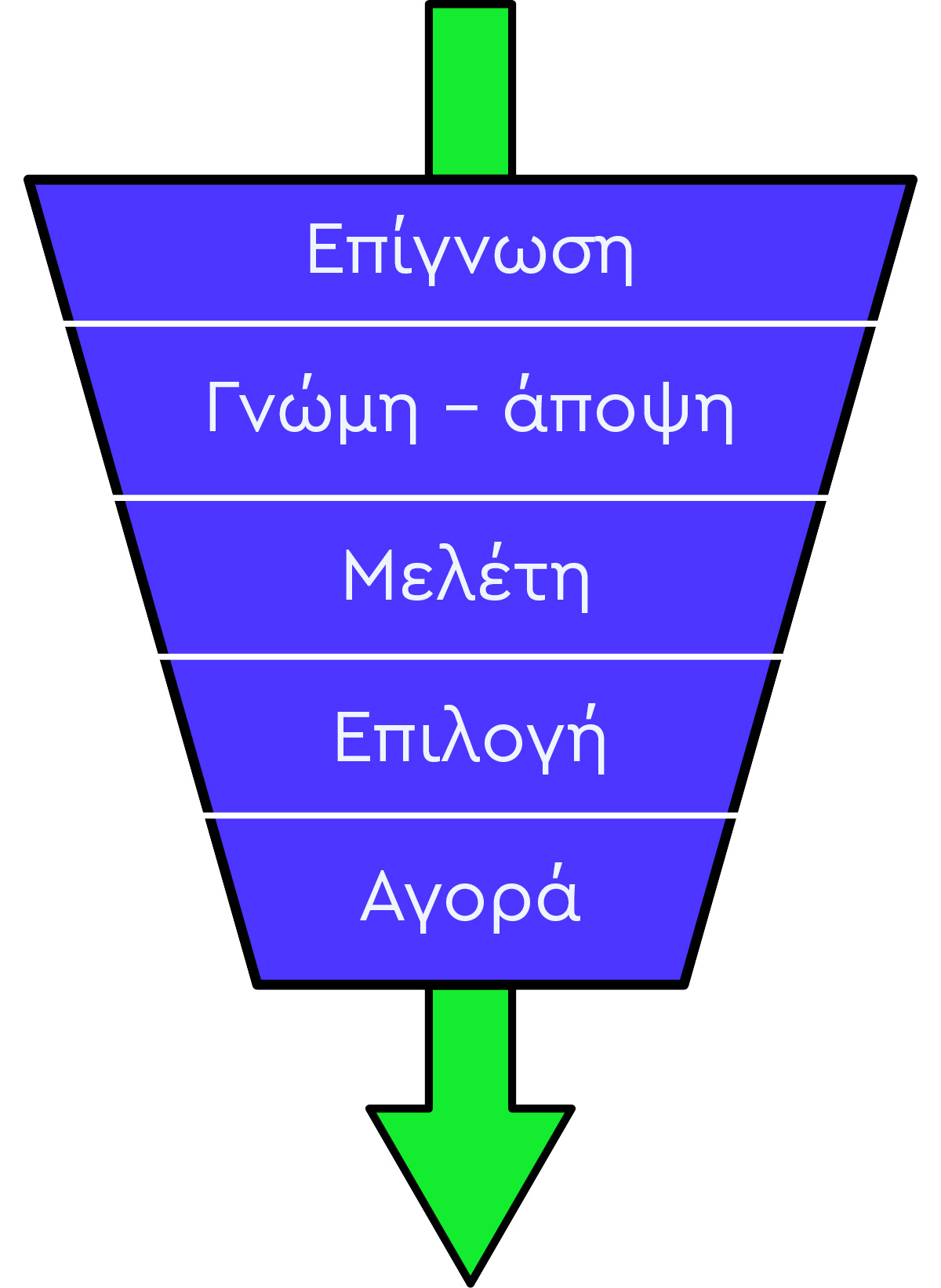
For example, with a single click in an e-commerce store, you are at the opinion - view stage and soon move to the consideration - study phase to make a purchase.
Although traditionally “purchase” referred specifically to acquiring products and services, today the term can mean anything that is the core business of an online presence, as seen in Chapter 3: The Business Goal.
It could be, for example, signing up for a newsletter, participating in an event, subscribing to a service, etc.
At this point, search intent comes exactly into play, and this analysis will indicate at which exact point of the pyramid the prospective customer is so that the response is as suitable as possible to guide them to the next step until final conversion.
Google itself has published in best practices for managing a website that it considers the recognition of search intent highly important, and consequently servicing that intent in the best possible way (searchqualityevaluatorguidelines.pdf).
In Chapter 5: Search Engines, we saw that according to Google, people use search for many reasons, from getting answers to practical questions like “where can I buy these shoes?” to deeper and more philosophical ones like “who do I want to be?” etc.
The reasons people search are divided by Google into 6 basic categories—or 6 basic human needs—which are to take an action (to do something), to understand & learn (to understand or learn something), to belong somewhere, to enrich an experience, to improve themselves, and finally for self-exploration (google link).
Search engines evolve continuously aiming to provide the best answers to the queries asked because only if they provide good results will users continue to use and trust them, keeping them on their pages and showing ads, which is their ultimate and final goal.
To respond with appropriate results to entered queries, search engines try to understand the motives behind them and not just the meaning of the words.
These motives fall into 3 basic categories, each served by a different type of result:
- Transactional queries. In these, users seek an imminent transaction, such as buying a book or a smartphone, etc.
- Navigational queries. Here, users seek guidance to visit a specific site or app, e.g., Skroutz, YouTube, etc.
- Informational queries. In these, users look for specific information, e.g., “how to make coffee?” or “what are the symptoms of covid?” etc.
Regardless of the core business and the goal for which you created and maintain an online presence, if you want to do it right and effectively, you must be able to distinguish the intent behind searches and try to serve that intent as best as you can to have a chance to convert visitors into customers.
In Chapter 5: Search Engines - we saw that Semrush.com, a tool for SEO and Marketing, offers information for categorizing searches based on intent (fig. 10.2).
Image 10.2: Semrush.com’s division operation based on search intent.
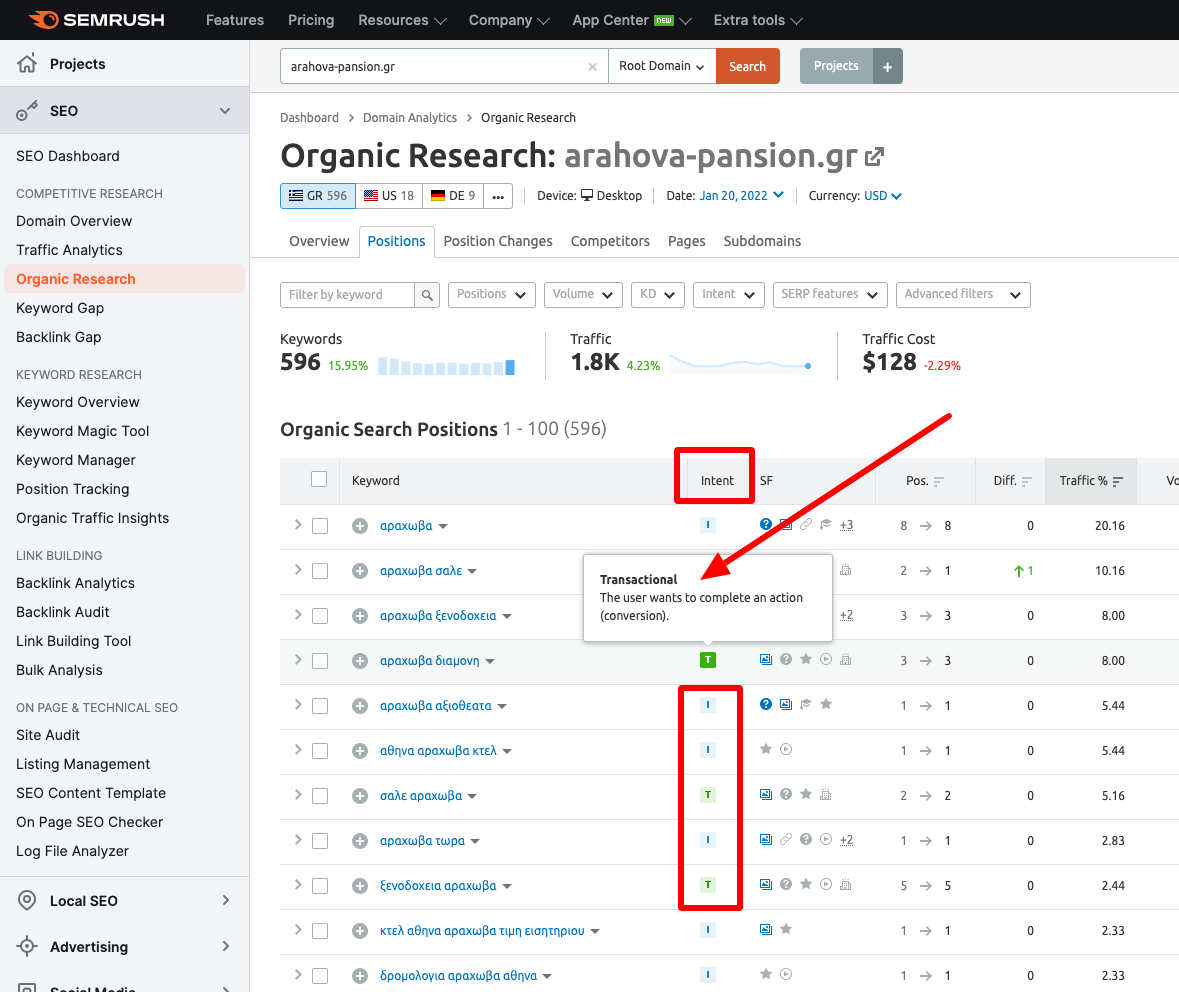
But let’s see how someone could identify search intent and achieve better ranking for something of interest without acquiring Semrush.
Intent Recognition
The good news is that all you need are the Google search results for the query itself and to be able to correctly read and analyze these results.
Let’s take the search “website development” as an example. These are the Google results from top to bottom.
Image 10.3: Google results for the search “website development”. \
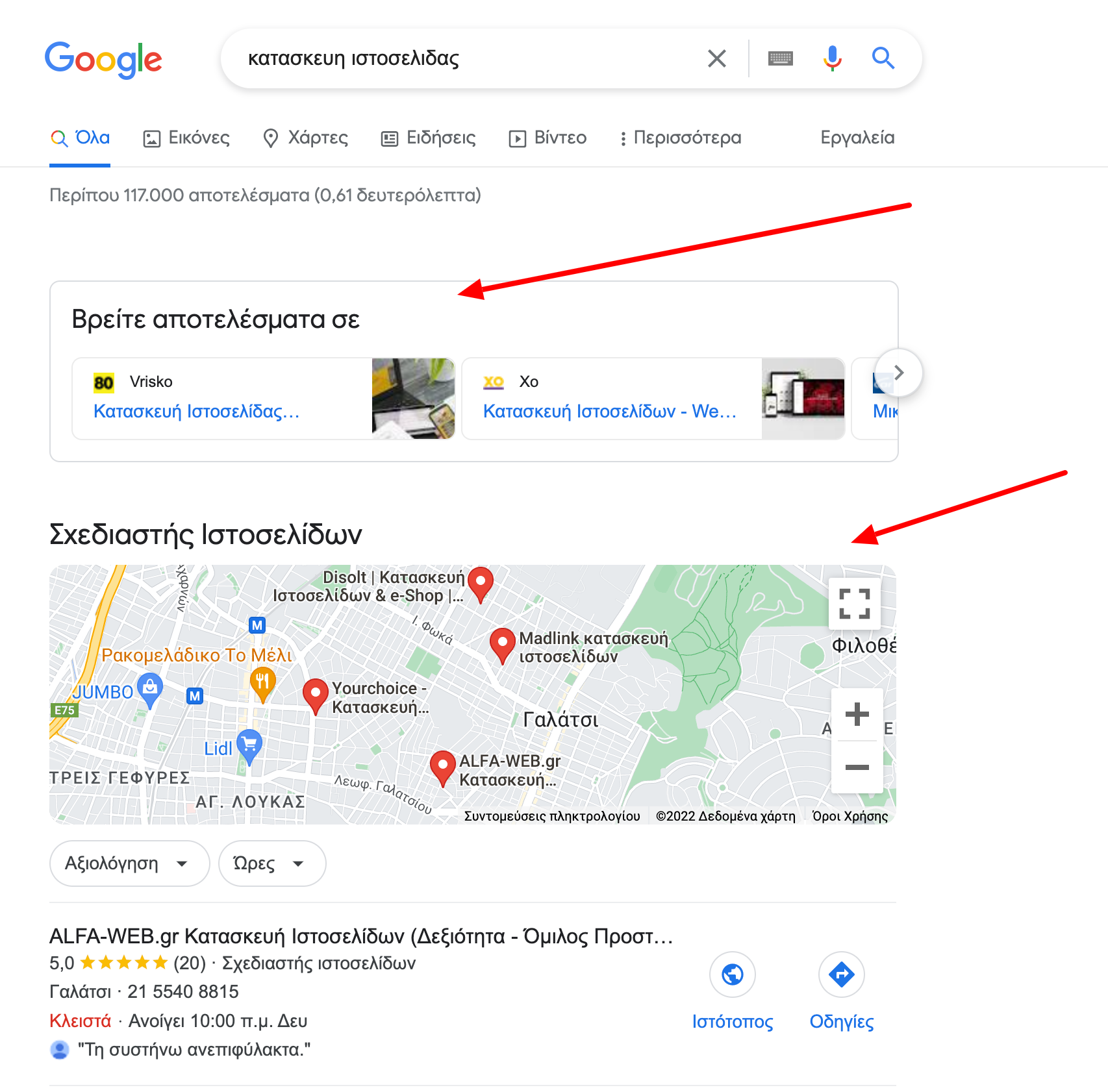
Initially, there is an info box with suggestions for results on sites Vrisko and Chrysos Odigos, which are sites for professional and business listings (transactional - transaction intent).
Below it is a map with businesses from Google My Business offering website development services (transactional - transaction intent).
Image 10.4: Google results for the search “website development”.
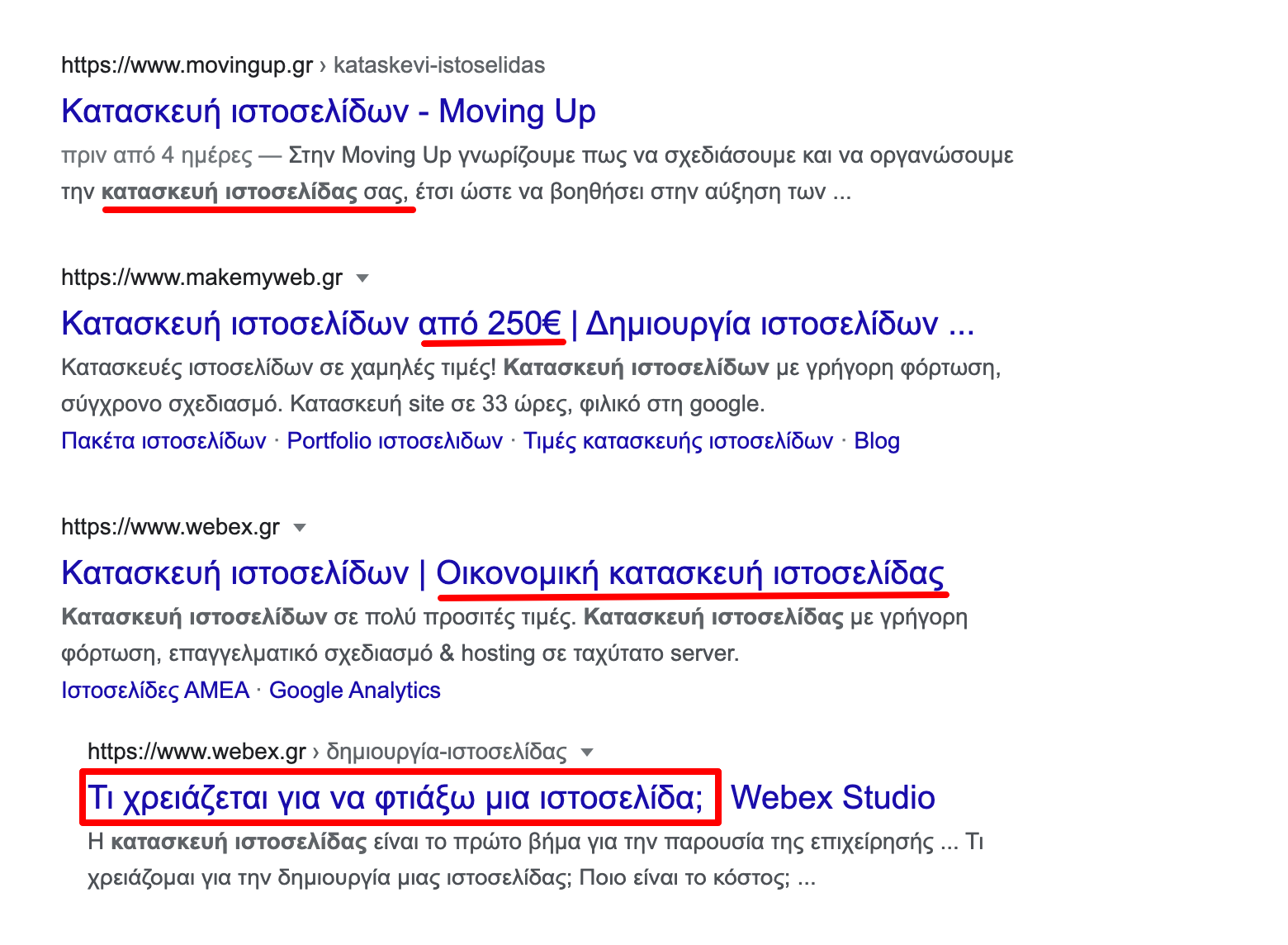
Below start the organic results, specifically a series of the first four (4) results.
The first three concern outsourcing website development work, as they include details about prices and implementation process (transactional - transaction intent).
In the third result, there is also a fourth mention from the same site (webex.gr) with information about what is needed to build a website (informational - informational intent).
Image 10.5: Google results for the search “website development”.
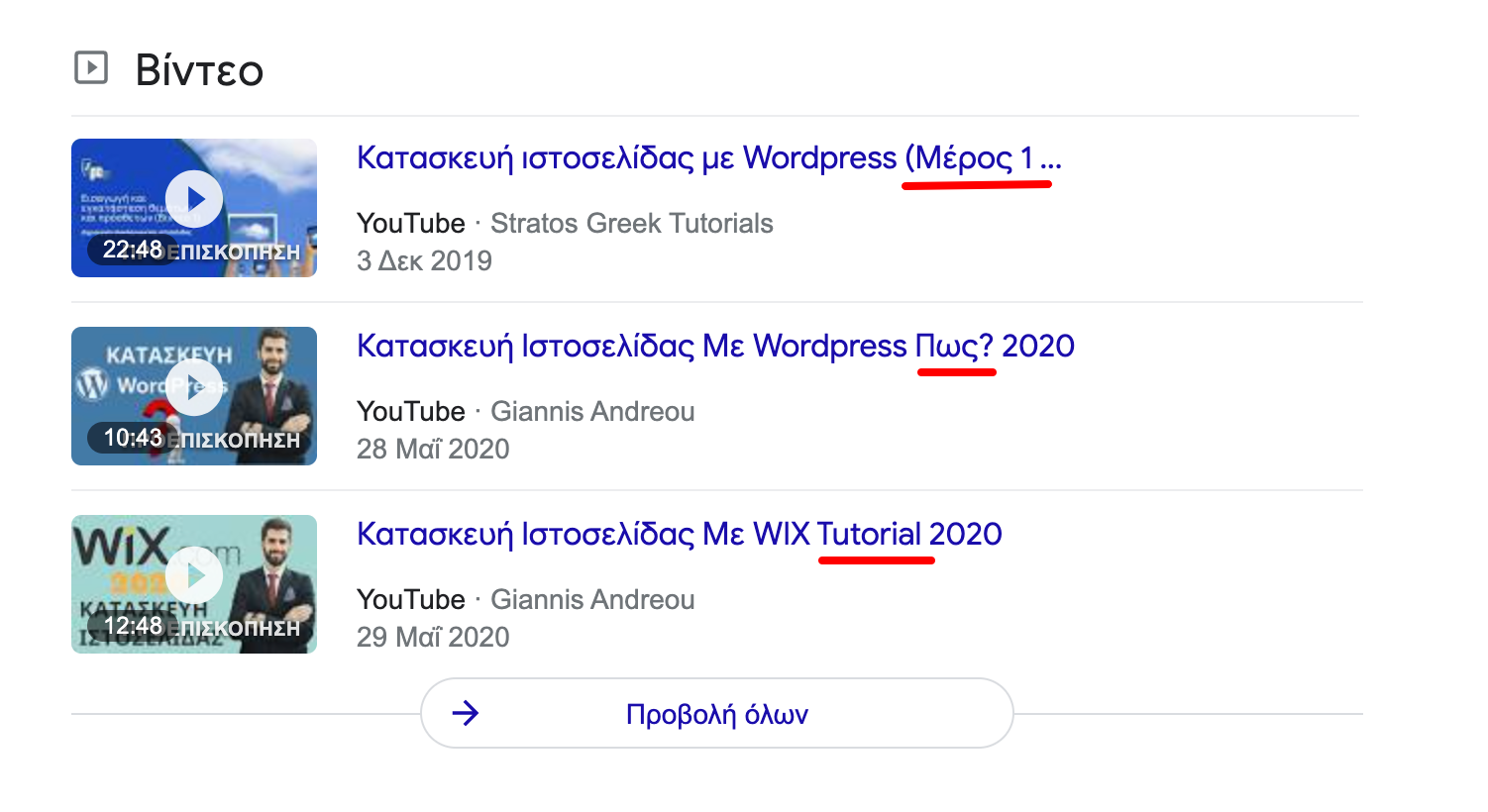
Next, there is a section with videos from YouTube. These videos are practically guides to creating websites from WordPress and Wix platforms (informational - informational intent).
Image 10.6: Google results for the search “website development”.
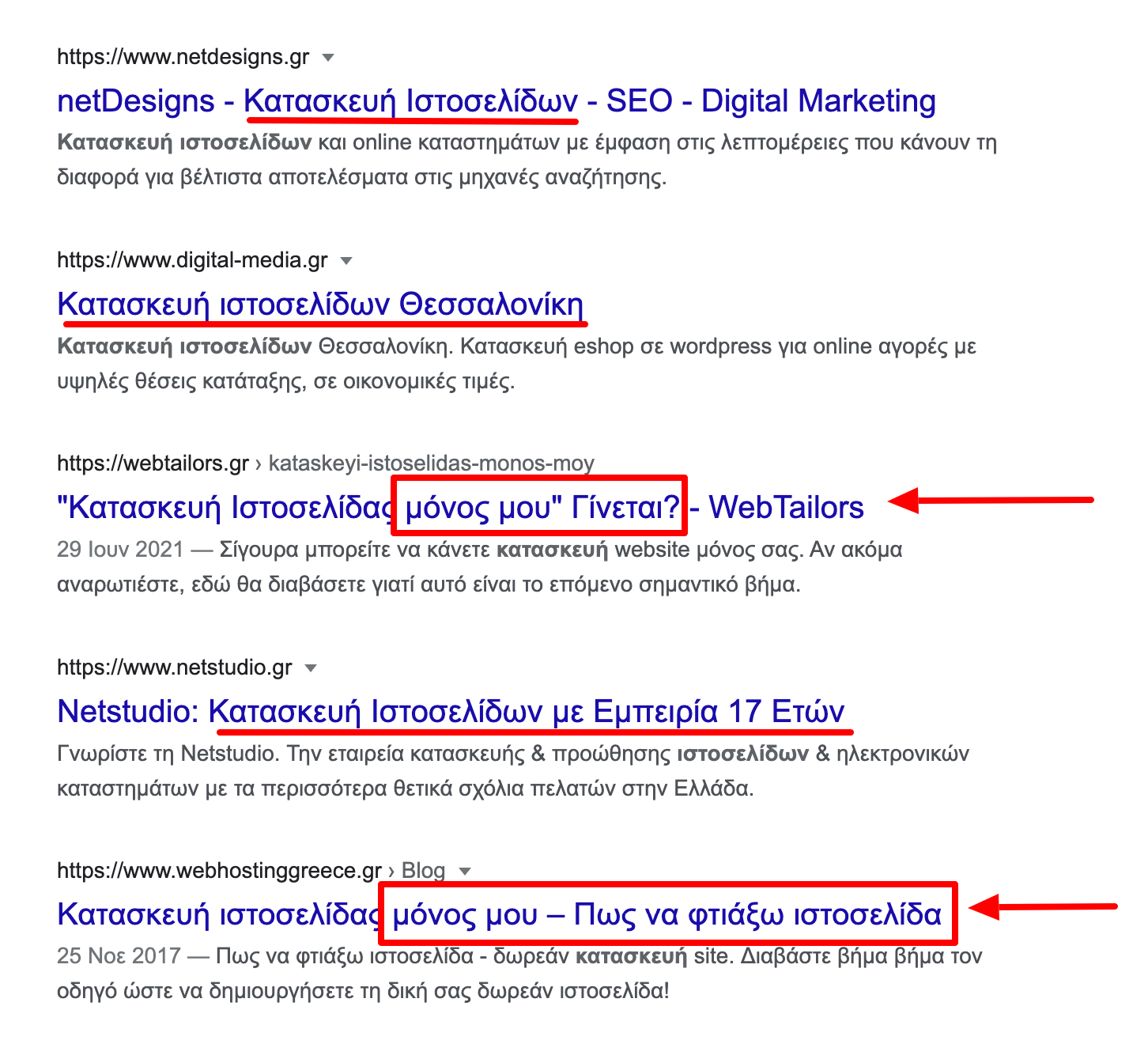
Below are the remaining 5 organic results, 3 of which concern companies for outsourcing website development work (transactional - transaction intent) and 2 are informational guides on how to learn to build websites by yourself (informational - informational intent).
Image 10.7: Google results for the search “website development”.
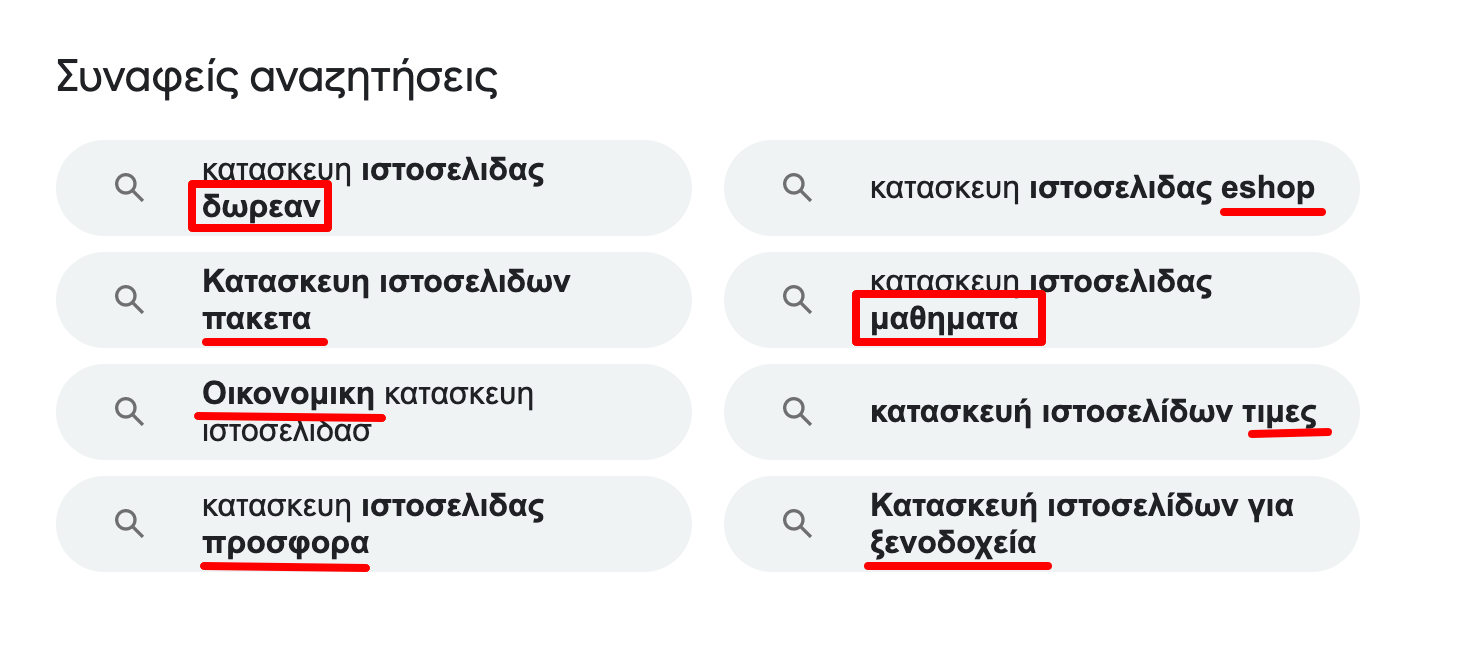
Finally, there is the related searches section, where 6 out of 8 relate to outsourcing development and financial interest for website development, e.g., offers, packages, eshop, for hotels, etc. (transactional - transaction intent) and 2 concern learning and free implementation, presumably with cost shifting after the build (informational - informational intent).
Therefore, overall, we distinguish 2 types of intent in this search: 1. Transactional and 2. Informational, with frequency ratio and thus weight about 75% - 25% favoring transactional intent.
This means that if you try to write content for information and education about website development, you will probably never reach the 1st position, no matter how hard you try: for Google, the search intent is transaction!
Much more so, you will not succeed if you try to exploit this search for navigation purposes to a company site named, for example, “Website Development”.
Many used to buy a domain based on their main search: there was a perception, and it was true to some extent, that an exact match domain boosts its rank in search results.
This is no longer possible today and can’t happen, because it is absolutely certain that Google will not show a site named kataskevi-istoselidon.gr without related or good content about transactional and informational searches about website development if it relied only on the domain.
In Chapter 2: Preparation - Pick your battles, I mentioned my own experience about continuous efforts to conquer the 1st position in a search that in hindsight was not a very wise choice.
Not very wise because I didn’t analyze the intent behind this search and, as I understood, it cost me time, resources, and ultimately money.
My main goal was for visitors planning a trip to Arachova to find the family guesthouse and book their stay, so I targeted the main keyword, which was the name of that mountainous destination: “Arachova.”
After 4 years of effort, I succeeded! My page was 1st for the search term Arachova, even before Wikipedia!
However, despite success in ranking and visitor increase to the website, I saw that interest in accommodation and guests at the business remained relatively stable, although the number was very satisfactory.
This can be easily explained by search intent; today I wonder how I missed it then: the search term “Arachova” is very general and the intent behind this search is not clear. Someone could search it while planning a trip, looking for accommodation, geographic info, already booked accommodation looking for bus/taxi phone numbers, weather, a specific business, food and entertainment info, attractions, and many other things.
Now, having data from Google itself, I can confirm there are at least 1,000 searches including the term “Arachova”. Many do not serve the intention or business of the guesthouse, which is lodging.
So, I stopped targeting “Arachova” for Arahova Pansion: no reason to support it. I had to choose the battles I wanted to fight for the searches.
Today, arahova-pansion.gr focuses on key searches motivated by lodging.
Also, I have kept some regional searches that may not directly increase bookings but maintain some traffic and contribute indirectly to business success.
By thoroughly analyzing the Google Search results of a query that interests you, you can fairly easily understand Google’s intent for that particular search.
Besides the info in the website development example, you can also use tools like image search, video search, and other search engines like Bing and Duckduckgo.
Knowing search intent beforehand lets you focus better on building a page that quickly and deeply answers, thus serving that search intent well.
By serving the intent, you can give your own solutions and directions to visitors who want to move to the next step and have more chances to convert them to customers.
We will see this next.
Serving Intent
1. Navigational Searches
A navigational query is a query entered with the purpose of finding a specific website or webpage.
For example, a user might type “youtube” in Google’s search bar to find the YouTube website instead of typing the URL in the browser or using a bookmark.
In fact, “facebook” and “youtube” are the top Google searches. Both are navigational queries.
It is a fact that you have very little chance of success if you target a navigational query unless you happen to own the searched site.
Real navigational queries have a very clear intent, the user has a specific site in mind, and if you do not own it, you are irrelevant to their needs.
Google, which refers to this query type as a “go query,” has even decreased the number of results on the first page from 10 to 7 for these queries, reducing total clicks by 5.5% on the first page’s organic results.
However, some queries that seem navigational may not actually be.
For example, someone searching “facebook” might be looking for news or info about the company.
What you should first do as a site owner is make sure you own the first place for your brand’s navigational query.
Ideally, your site will appear at the top organic position as well as non-organic mentions, like Google Maps, Google My Business, or the content graph on the right of organic results.
Image 10.8: Google results for the search “arahova pansion”.
arahova-pansion.gr holds the 1st organic position, content graph on the right, and on the map.
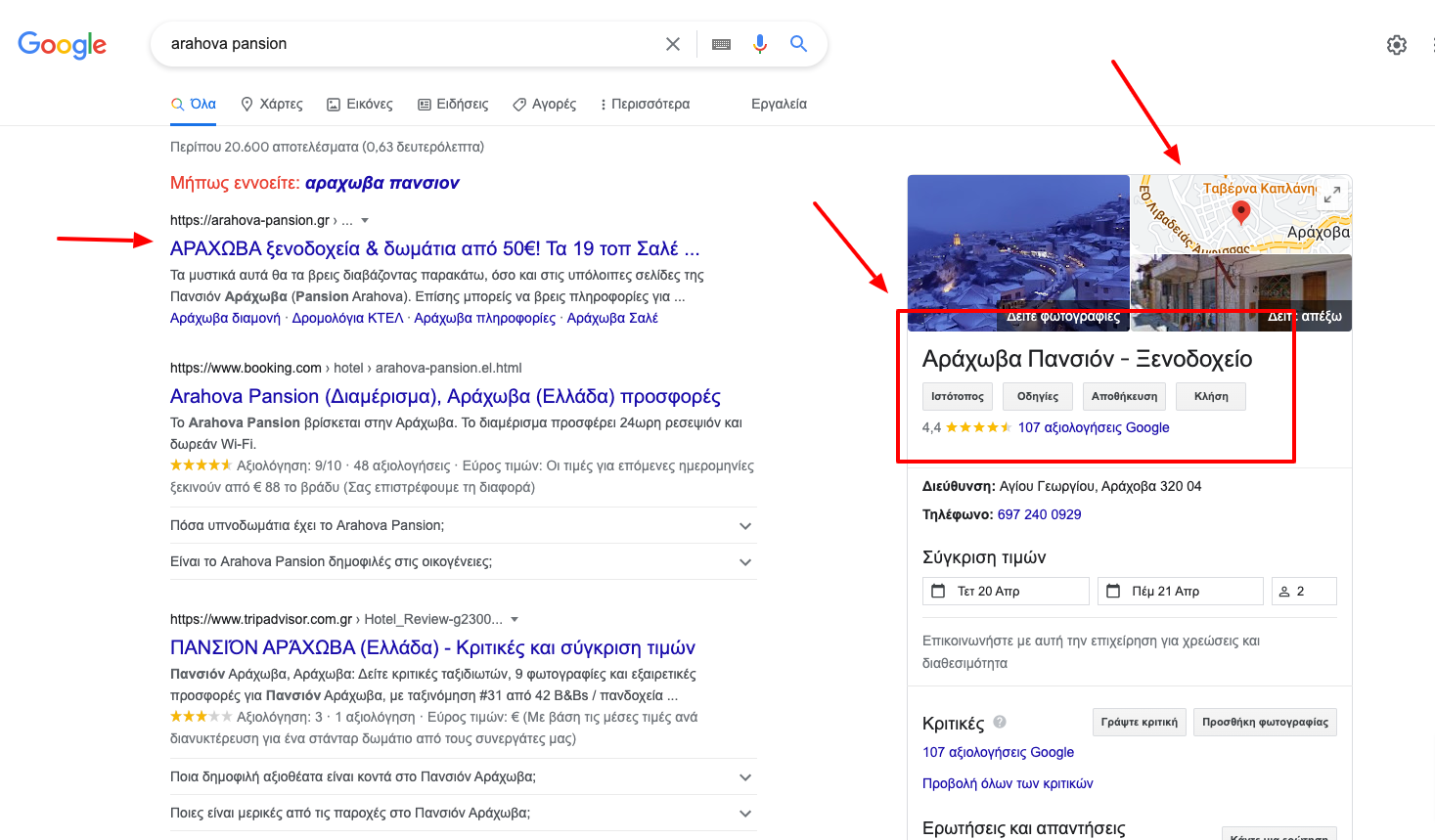
If you want to rank well for another company’s navigational query without managing its official site, you might want to rethink that.
Maybe it’s not such a good idea.
2. Informational - Educational Searches
Wikipedia defines informational search queries as “queries covering a broad topic (e.g., Colorado or trucks), which may have thousands of relevant results.”
When someone types an informational search query into Google Search or another engine, they seek information—hence the name.
They probably don’t look for a specific site as in a navigational query, nor want to transact. They just want an answer or learn how to do something.
Such a general query is the search “Arachova” mentioned earlier, broad enough alone to lead to something very specific.
Informational and educational queries generally have a hard time generating revenue.
Google knows this, so it created the knowledge graph (content graph), which is general information further divided into sub-searches answering specific intents to serve these query types.
Image 10.9: Content graph in Google results for “Arachova”. Content is divided into logical sections like “activities”, “accommodation”, etc.
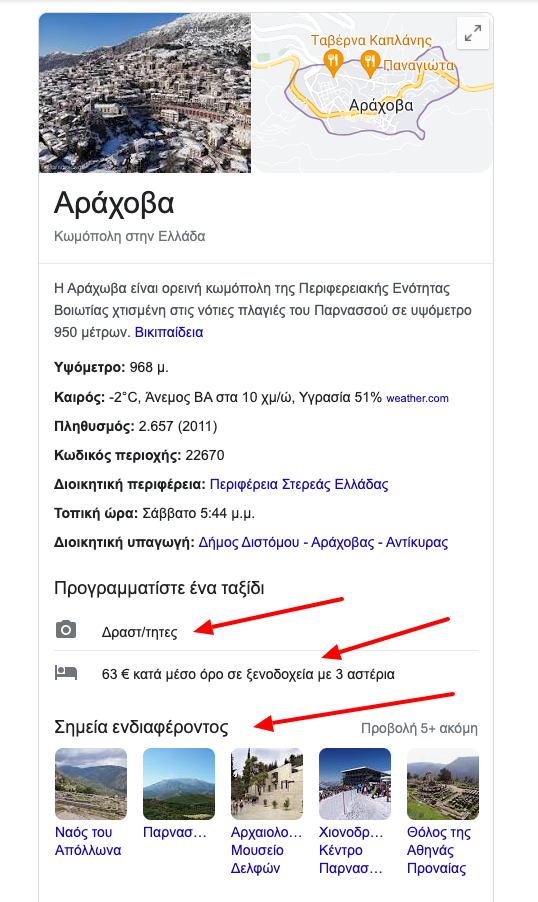
The best way to target informational searches is with high-quality content providing truly useful info relevant to the query.
Practically, you should be at the place where Arahova-pansion.gr was when ranked 1st for “Arachova”: it had all info, best structured, visitors found answers for almost every intent—lodging, food, transport, weather, etc.
Wikipedia, despite flaws, is very good at providing basic, reliable info on a wide range of topics, ranking high for millions of searches (including “Arachova”).
However, Wikipedia leaves room for other informational queries.
There you could target to serve informational queries to gain good rankings to increase traffic and customers via organic search.
Content with advice useful to those making informational searches could easily win a high position in results.
For example, if you are a public relations consultant, you could write a page about how to create a press release.
A video with instructions related to your business is also useful to many.
A detailed, step-by-step guide clarifying a process related to your business can also be helpful.
An infographic, graphical representation of data and info, presents complex info more understandably, helping readers memorize better.
This presentation is very effective as the human brain processes images much faster than text.
Adding the fact that information now travels fast, explains why infographics are so attractive.
There are many ways to approach informational content. The key is to be creative.
The goal is to position your presence as a credible, authoritative source of info, not to sell your products.
This is your chance to increase your brand awareness.
If you can answer a visitor’s informational question, they are more likely to consider your business in the future if they need your type of offers.
Here I mention the example of Arahova-pansion.gr’s page about KTEL bus routes.
One of the most popular searches leading to arahova-pansion.gr is “athina arachova ktel”.
In fact, it is the most frequent search from which Arahova Pansion visitors arrive during 01/2022 to 03/2022.
On this query, which is among the most popular searches for Arachova, arahova-pansion.gr is #1 organic, above the official KTEL site operating the Athens - Arachova route, where tickets can be booked!
Image 10.10: Search results for “athina arachova ktel” on Google Search. arahova-pansion.gr is in 1st place, above the official KTEL site.
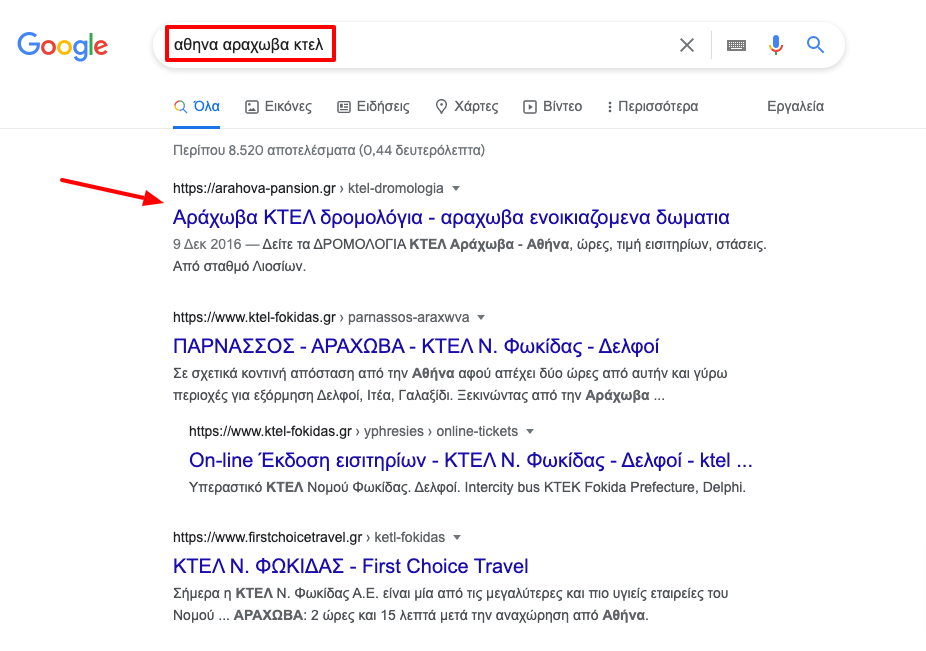
When I recognized this search’s value, I chose to create content competitive for those who would search for it, based directly on the intent behind this query: they want quick schedule and fare info to plan their trip to Arachova!
Official organizational pages like KTEL often are outdated (when they exist) and info/functionality is not what a young user expects today.
So, it was not hard for my offer to be the most useful.
I simply put a table with schedules, prices, KTEL contact info and location, Athens - Arachova route duration, etc.
Also, I added a button for visitors to call KTEL directly for ticket booking.
Image 10.11: KTEL schedules page on arahova-pansion.gr.
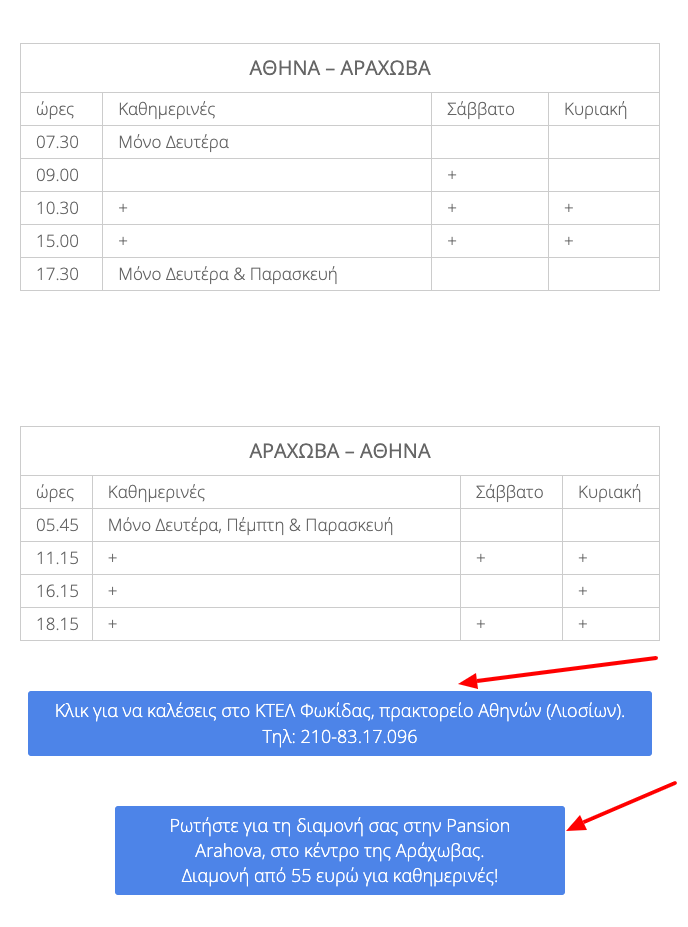
What I did after those basic infos, for which visitors clicked initially, was to add another button for booking accommodation at Arahova Pansion if desired, and a functionality to search accommodations in Arachova via the Booking platform.
This page became the most successful on arahova-pansion.gr, and in Google Search results for “athina arachova ktel” it is outstanding: 6 out of 10 users searching this term visit Arahova Pansion, an amazing conversion rate that Google would never rank lower than first!
The success is such that even KTEL, when they changed their schedule due to coronavirus, called me to update the info since many were calling for tickets for non-existent routes.
Of the thousands served daily by this page, surely some inquire for more info about lodging at Arahova Pansion, other Booking rooms (for which Booking gives me a commission if booked), some are led to links with tips for Arachova trips, and some remember the Arahova Pansion brand for future visits!
Smart, don’t you think?
😁
3. Transactional Searches
A transactional query is one indicating intent to complete a transaction, such as purchasing a product.
Transactional search queries may include exact brand and product names (like “iphone 13 pro”) or be generic (like “espresso coffee maker”), or include terms like “buy”, “skroutz”, “order”, etc.
Image 10.12: Search suggestions for “iphone 13” on Google Search.
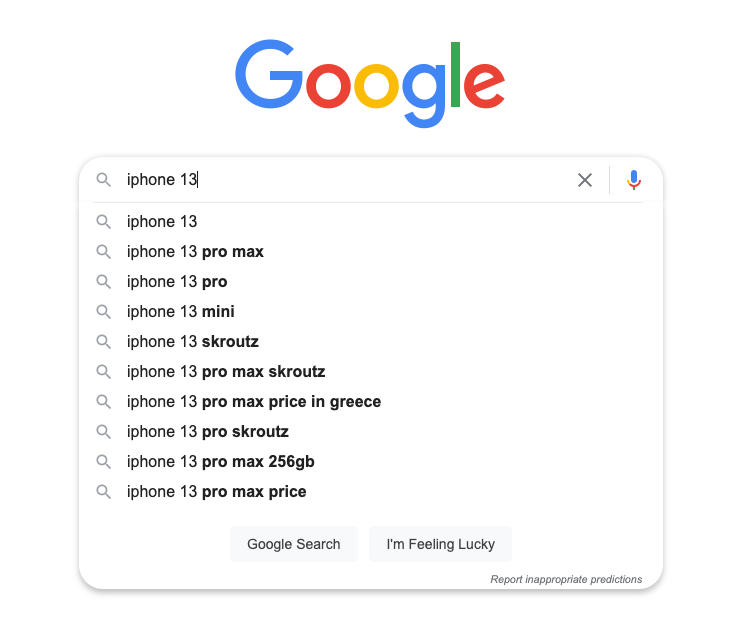
In all these examples, you can tell the user is thinking about purchasing soon if they haven’t taken out their credit card already.
In other words, they are near the bottom of the buyer’s journey pyramid we saw above.
More specialized searches (vertical searches) are also transactional and done by people wanting to transact in a specific sector.
These include local searches, restaurant searches, hotel searches, flight searches, etc.
Google’s recent moves for immediate targeting of vertical searches have led to antitrust allegations in various countries.
Because these searches are often highly competitive, i.e., many quality results, you should initially consider if you will enter the effort to rank organically or if it is more economical midterm to pay for Google ads.
Image 10.13: Advertisers on the search term “iphone 13” on Google Search.
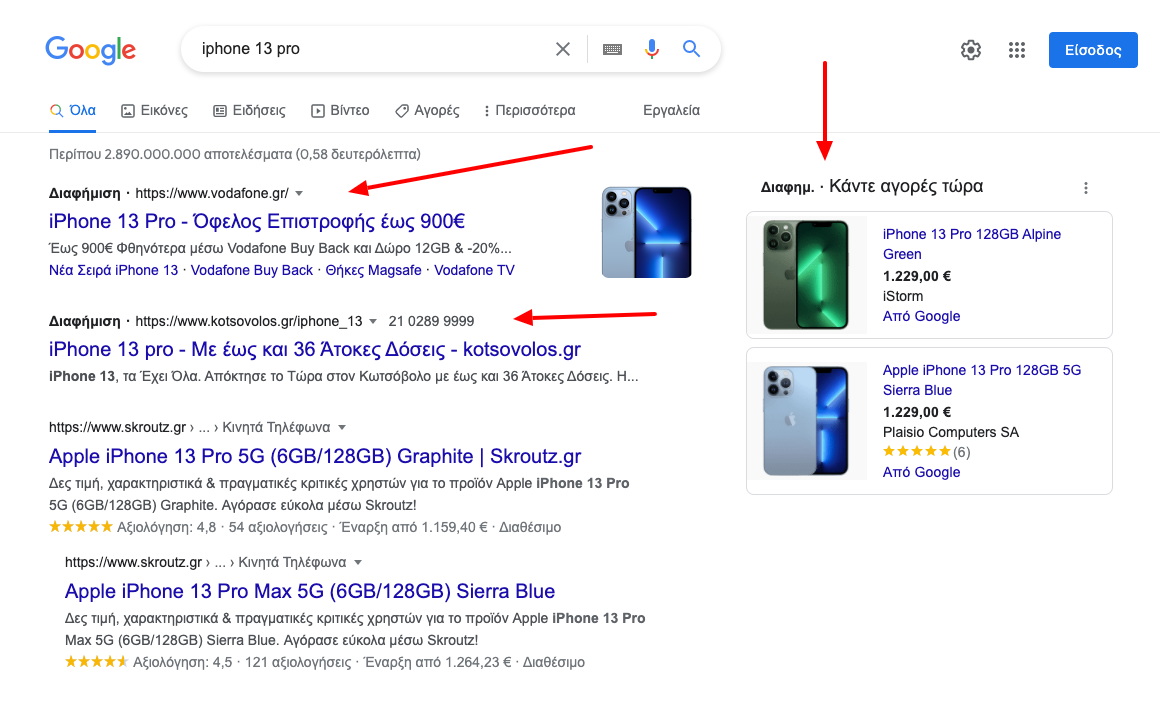
These query types usually offer good ROI for paid search.
If people are searching for a specific product to buy, an ad is as likely to convert as organic results.
Sponsored results occupy large space in Google Search for commercial/transactional queries.
Google offers many ad and product listing options.
For example, you can include an image of your product.
Your organic result options are more limited and less controllable.
Studies have found people click twice as much on paid results vs organic in high commercial intent queries.
This is likely because sponsored results take up much visible space, new ad formats are impressive and clickable in many places, and many users can’t easily distinguish ads from non-ads.
Apart from sponsored ads, a tougher solution is organic ranking.
As Skroutz.gr dominates many commercial-transactional searches in Greece, the best way is to see exactly what Skroutz does and try to emulate it.
Skroutz.gr has published its SEO principles in its Engineering Blog.
You can read it here: engineering.skroutz.gr/blog/seo-in-skroutz-our-top-5-principles-and-values.
The principles are:
- Serve the human, not the machine.
Exceptional user experience should be your first priority. Focus on the user’s journey and deliver the best experience at every step. - You cannot deceive Google long-term.
Avoid any forbidden SEO techniques. Google has evolved greatly and likely will penalize you. - Know your audience.
What info is most helpful to them? How to present content to help. What part removes doubts so user continues journey. - Create a quality page for every important query (for your company).
- Help Google know and understand your presence.
Sitemaps, avoiding duplicate content, good architecture, internal linking are very helpful.
Now you know how to correctly determine the search intent behind a query.
Search intent study is the process of identifying the “why” behind each search query.
This study should be an integral part of keyword research you undertake.
It helps determine competition based on intent and evaluate ranking potential for a keyword phrase.
By analyzing Google Search results for a query, plus related searches, “people also ask,” Content graph, keyword similarity, video/image packs, you discover people’s motives behind queries.
Then, you think how to align that motive with your business goal and find the best way to implement that alignment.
Remember the bus schedule page for Athens - Arachova and how arahova-pansion.gr benefited from an intent not fully compatible with its business.
Your options are endless.
Let your imagination run free and you are sure to find amazing ways to connect and attract potential customers.
Things to Keep in Mind:
- Identify visitor intent for your pages and serve it as best as possible.
- People search for info to do something, understand something, belong somewhere, enrich an experience, improve themselves, and finally for self-exploration.
- Be creative. The goal is to position yourself as a reliable info source, not to sell your products.
Cover image source: Unsplash.com